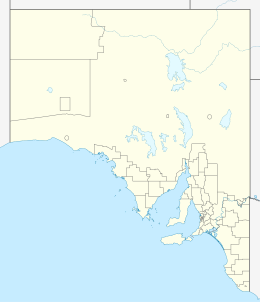Beatrice Islets
| Geography | |
|---|---|
| Location | Nepean Bay |
| Coordinates | 35°38′26″S 137°40′55″E / 35.64057°S 137.68208°ECoordinates: 35°38′26″S 137°40′55″E / 35.64057°S 137.68208°E |
| Area | 10 ha (25 acres) |
| Highest elevation | 0 m (0 ft) |
| Administration | |
|
Australia
|
|
| Demographics | |
| Population | 0 |
Beatrice Islets are pair of islets in the Australian state of South Australia located in Nepean Bay on the north coast of Kangaroo Island about 4 kilometres (2.5 miles) east of Kingscote. The islets and adjoining intertidal areas are notable as habitat for bird life. The islet pair has enjoyed protected area status since 1909 and since at least 1972, have been part of the Beatrice Islet Conservation Park. During either the 1960s or the 1970s, the islets were extensively damaged by an exercise to remove an infestation of South African boxthorn.
Beatrice Islets are pair of islets located in Nepean Bay about 4 kilometres (2.5 miles) east of Kingscote on Kangaroo Island in South Australia. The Beatrice Islets along with Busby Islet are three high points on the southern edge of a spit that is exposed at low water. The spit which is named ‘The Spit’ extends from Cape Rouge about 5 kilometres (3.1 miles) north of Kingscote in a south easterly direction across the opening of the Bay of Shoals for a distance of about 5 nautical miles (9.3 kilometres; 5.8 miles). The islets which are separated by a distance of about 1.25 kilometres (0.78 miles), have a north-south alignment. The islets historically consisted of sand dunes that were permanently above high water. However, an exercise to remove South African boxthorn, an introduced species considered to an infestation risk, which occurred either during the 1960s or the 1970s and which resulted in the islets becoming ‘susceptible to erosion, and tides and rough weather’ thereby reducing the ‘once stable vegetated islets to bare, wave-washed sand spits’. Subsequent attempts to stabilise the islets and encourage the deposition of sand were unsuccessful. As of 1987, the islets were reported as existing ‘only as a mudflat/cocklebed which emerges above the sea at low tide.’
The conditions for the creation of The Spit and therefore Beatrice Islets and Busby Islet became possible about 7500 years ago when sea levels reached current levels. The islets are composed of sand and sandgrit. The islets is part of a drying spit at low water which falls to a depth of 5 m (16 ft) within about 0.6–1.25 km (0.37–0.78 mi) to the west.
...
Wikipedia

